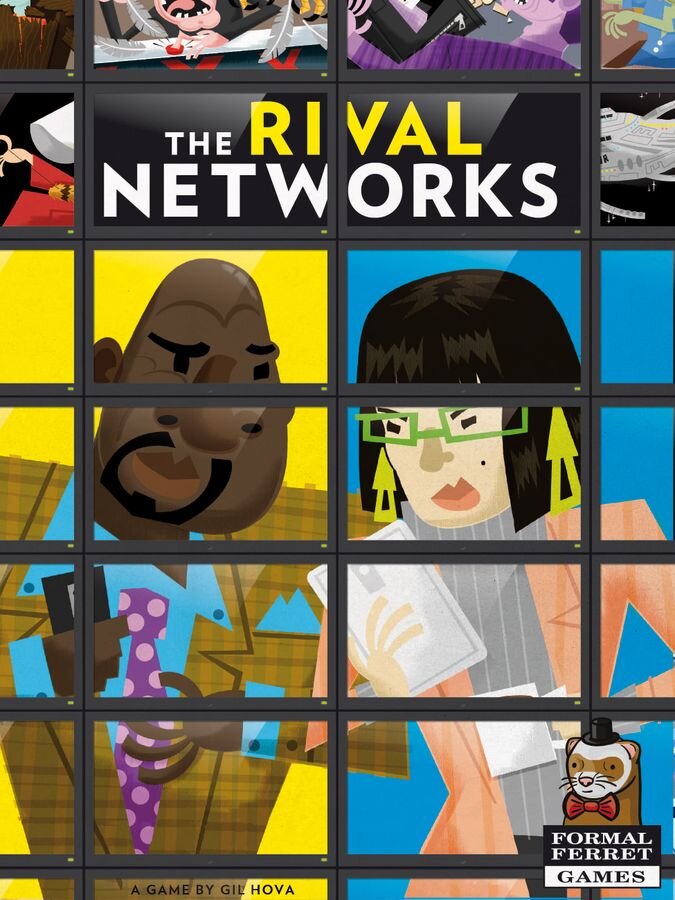The Rival Networks – First Impressions
Review copy provided by the publisher
In 2016, The Networks decided to wrangle the silver screen into the board game world and poke fun at all of its quirks in a competitive battle of the networks, where Shows, Stars, and Ads are the primary currency of the day and the ultimate goal is to get those eyeballs, those Viewers, to sit down and be mesmerized by the intoxicating brew of spicy TV with sultry Stars and salacious Ads. Getting the right combinations would be ocular overload and help to rake in the Viewers.
Now, five years later, players can now dive back into the zany haze of big screens in the house with a two-player version of that older formula. Gil Hova and Formal Ferret Games have brought us The Rival Networks, which introduces new Show parodies, more pitiable Stars, and a slew of Ads that will make your eyes cringe.
It’s a visually arresting game, though with art from Heiko Günther and Travis Kinchy. The illustrations and clever writing in the game make up some of the allure of The Rival Networks, so it’s important to note the valuable contributions that these artists have made to Gil Hova’s design.
And whereas The Networks may shine best with more around the table, The Rival Networks only needs two. Just you and me. So let’s sit down and study this little game.
What It Does
Welcome to the TV business!
You are the owner of a new television network. All you have are three awful public access shows, a small amount of cash, and endless ambition. Plus, it looks like there is another new TV network in town, and boy, do they look like competition...
That’s all you need to know. You’ve got a network. It’s got three crappy shows. You should kick them to the reruns as soon as possible and start to fill the primetime slate with as many juicy and eye-catching shows as possible.
The Rival Networks puts two players in direct competition for the best Shows with the most appealing Stars. Using those two in conjunction with clever Ad placement, players will bump up the Ratings and start to attract Viewers.
Across three Seasons, players will compete for the best-rated Shows and aim for the Season Awards that offer a little boost of Viewers or Star power to the player(s) meeting the criteria. And each turn is pretty simple as well. Players will:
Develop a Show (or end the Season). It either goes straight to reruns (not recommended unless you just have amazing Shows already in each time slot) or it will replace an old show, which will reset the Ratings but give the player a chance to pull in more Viewers.
Sign a Star and take an Ad, both of which go to the Green Room. The Star (along with any others in the Green Room) can be assigned to one Show as long as their Genres match the Show in question.
Purchase a Network card (if the player has enough money from their collected Ads).
Use a Network card at any time during the turn.
That cycle continues, switching back and forth between the players, until either a Season ends and a new one starts or the end of the game arrives.
How It Does It
This is a card game with light economic mechanisms (using Ads to buy the Network cards). But the main system involves players building Shows at the right time slots with the right Stars and activating the right Genre Bonuses.
That combo-ing is the potatoes of the game. Boil ‘em, mash ‘em, stick ‘em in a stew. The meat resides back with The Networks. This is a starchy, carb-filled snack of mechanical fun within Gil Hova’s TV fever dream.
And the snack in question is made of card drafting (developing a Show), influence majority (Rating points on Shows), and set collection (Genre Bonuses). Stir those three and baby, you got a stew going!
The Network cards provide some manipulation of the core rules but it’s the interplay between the three mechanisms above that breathe life into The Rival Networks.
Why You Might Like It
The humorous reflection of the TV entertainment business is on full display in the absurd shows and maladjusted stars that feature in them. The parody is part of the experience in The Rival Networks, just like in Gil Hova’s other design.
Between the Genre Bonuses, Network cards, and Season Awards, there are enough interesting decisions to keep players engaged throughout the 30-45 minute playthrough.
Why You Might Not
Unlike in The Networks, players will see every card in the game every time they play, which means that the comedic return on the Shows and Stars will lessen with each play.
Given the reduced amount of content for the game (which allows it to fit in a smaller box and be more accessible to new and returning players), it’s entirely possible that players could get stuck in a rut regarding how they approach strategy in the game.
Final Thoughts
The Rival Networks was a fun experience. Enjoyable to play and interesting to explore, there are enough mechanics blending together to create tension in players’ decision-making.
I do wonder if that tension and that fun will remain at the same levels over time, though. It’s possible that players won’t see all of the Stars in a single game, but players will always see the same 18 shows every game, so the silliness and novelty of those will likely wear thin, which robs The Rival Networks of some of the joy that players will feel the first few times they sit down at the table.
That linear reveal of shows that stays static is necessary to make the Genre Bonuses attainable for all players, but it develops a certainty to the game’s progression which could impede the game’s longevity. After about 3 or 4 plays, you’re not going to be surprised by the cards and artwork anymore, which is a shame given how satisfying it is when you’re experiencing it for the first (or second) time.
While The Networks is best at higher player counts, it can be played with two people, so players who enjoy that game and appreciate the greater volume of variety that’s present there may be satisfied to keep playing with the big sister rather than shifting to this small-box head-to-head encounter.
But if you’re looking for a faster-playing, accessible version of Gil Hova’s distinct take on the world of television, then The Rival Networks could definitely be a game for you. It’s funny, engaging, and easy to break out of the box.
If you want to check out The Rival Networks, you can visit Formal Ferret Games or read what the community thinks on BoardGameGeek.
The world of two-player games continues to expand and now it includes a head-to-head version of The Networks. Are you a fan of two-player adaptations?
Let us know in the comments and give a recommendation for other games of which to share our first impressions.




